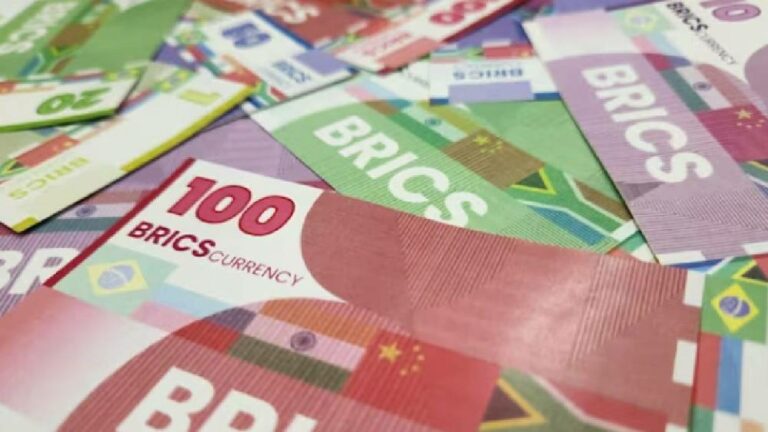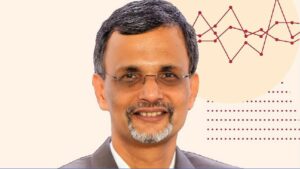BRICS aspires to internationally straighten the geopolitical conditions in favour of its member nations’ economic, geographic and demographic advantages. It has its multilateral New Development Bank (NDB), which is a powerful tool for BRICS to challenge the West’s dominance in global financial institutions. In line with this aim, the idea of a common BRICS currency has also been proposed. Russian President Vladimir Putin is advocating for independence from the US dollar and Euro due to Western sanctions.
In 2022, immediately after attacking Ukraine, Russian President Vladimir Putin suggested the idea of “alternative transfer mechanisms” with BRICS partners and an “international reserve currency.” Speaking to the BRICS business forum via video link on June 22, 2022, Putin mentioned that Russia was actively redirecting its trade and economic agreements to “reliable partners” such as India, China, and other BRICS nations to counter the crippling sanctions imposed by the European Union, the US, UK, and other Western powers.
Putin is advocating for independence from the US dollar and Euro due to Western sanctions. He argues that these sanctions disregard fundamental principles of a market economy, free trade, and the sanctity of private property. As a result, Russia is seeking new markets and strengthening its ties with nations in Asia and Africa.
BRICS, a bloc fashioned in 2009, aspires to internationally straighten the geopolitical conditions in favour of its member nations’ economic, geographic and demographic advantages. To attain this, the bloc founded the multilateral New Development Bank (NDB) in 2015, which assembles resources for infrastructure and projects in emergent markets and developing nations. Previously known as the BRICS Development Bank, NDB is a powerful tool for BRICS to challenge the West’s dominance in global financial institutions such as the World Bank or the International Monetary Fund. In line with this aim, the idea of a common BRICS currency has also been proposed.
Impact on Dollar
In times of economic emergency, for instance, the disparity between the price of gold and the actuality of the US economy in the late 1960s, the two oil disasters of the 1970s, the numerous financial glitches throughout the 1990s, the invention of the euro in the early 2000s, and the 2008 global financial crunch, many people expect that the US dollar will lose its significance as a global currency. However, these predictions have not come true.
While other currencies have gained relative weight in terms of their use in trade and as foreign exchange reserves for some economies, the US dollar still dominates the international market. It accounts for approximately 85 per cent of all foreign exchange transactions, 61 per cent of official foreign exchange reserves (down from 77 per cent in 1970), 40 per cent of international payments, and half of all international securities and cross-border loans issued by non-US residents.
The US dollar is widely accepted and provides liquidity for private transactions, which many other currencies do not. No other monetary system offers as many “investment grade” government bonds as the United States. Additionally, potentially competing currencies are hindered by a lack of proper financial system regulation in the country they represent. The use of a dominant funding currency globally can be beneficial as it creates economies of scale and network effects, which in turn reduces the costs of transferring capital and risks within the financial system. It also allows borrowers in foreign economies to access a wide pool of lenders and investors, thereby reducing funding and transaction costs.
However, it can also lead to a harmonised behaviour of actors in the international financial system, which upsurges the transmission methods of tremors halting from the US monetary policy and credit circumstances. This has often resulted in the US economy enjoying an “exorbitant privilege” as it can finance itself at a lower cost than other economies using the domestic currency, which places pressure on other economies. Trading in US dollars needs a double conversion from the two countries’ domestic currencies, making it a complicated procedure.
Creation of the Euro
Why shouldn`t there be other, more direct, ways to trade, avoiding such costs? The creation of the euro resolved a significant issue in Europe. However, the European Union is in a unique situation, as despite two-thirds of trade being conducted between participating countries, it took many years of experimentation to attain a common currency. Furthermore, not all EU countries use the euro, which raises doubts about its survival. Despite this, there remains discomfort with the role of the US dollar, particularly due to the weaponization of access to foreign exchange reserves in dollars through recent sanctions against Russia. This has led to a search for an alternative global financial and payment system.
Nations that belong to a certain group are anticipated to generate avenues to make trade and investments easier within the group. This helps to make the group more attractive and unified. The same is true for BRICS. Within BRICS, there is an increasing request for other avenues to lessen trade costs, including using currencies other than the dollar to clear up trade agreements. Some see the current situation as an opportunity to expand the use of other currencies and to create new payment systems. However, it is unrealistic to talk about a common BRICS currency at this time. Even the eurozone, which has unique characteristics and is geographically close, faces frequent problems and the Euro has not achieved the expected importance in global markets.
There is hope for progress in trade relations between countries. Instead of discussing the creation of a common BRICS currency, we should focus on developing a mechanism that enables bilateral trade. This mechanism could include periodic settlements, where hard currencies are only required to pay for the imbalance in bilateral positions. By doing so, we can substantially reduce the demand for US dollars and in turn, lower trade costs.
Since the 1960s, some policymakers in several countries and regions have looked for an alternate currency to the US dollar. However, the setback is that there is no natural candidate that can accomplish all the functions of the dollar in the short term. The expectations of economic agents play a crucial role in this, and presently, all the signs suggest that the US dollar still enjoys extensive acceptance. It should be noted that these arguments refer to a world without digital currencies. With the widespread adoption of digital currencies, many of these arguments may require a strong qualification and the relative weight of some currencies might change. However, it remains to be seen whether this will happen.
A Common Currency
The concept of a common BRICS currency is not really a requirement at this stage. In any event, it will likely manifest itself only after a global digital financial transformation has been completed, while there are other issues about who would run and be responsible for acting as the Central Bank. This question implies the development, perhaps like the European Union, of an inclusive bloc with common ideologies, technical capabilities, and a desire to remain free of the United States foreign policy demands as are currently implemented on a global basis. That issue is also being discussed, albeit at the early stages.
China, India, and Russia – all members of the Shanghai Cooperation Organisation (SCO), have been instrumental in asking the questions as to whether that entity could merge in some form with the Eurasian Economic Union (EAEU). There have also been initial discussions concerning adding to this the nations who have signed up to the Belt and Road Initiative. Given that 148 countries currently have such agreements in place, this is a significant figure that would position the world’s trade in a completely different format to the current organisational structure.
These are longer-term views, however, one advantage that countries such as China have is the lack of operational distractions created by ever-changing policies as a result of a surfeit of democratic governance, which in itself is in the process of going off the objective rails. Many do not expect to see any meaningful debate concerning the creation of an Eastern version of the EU anytime soon – partially because there already is one in the form of ASEAN. But when ASEAN creates a Central Bank and a common currency, one can be sure that the BRICS and its numerous allies will likely not be far behind.





















